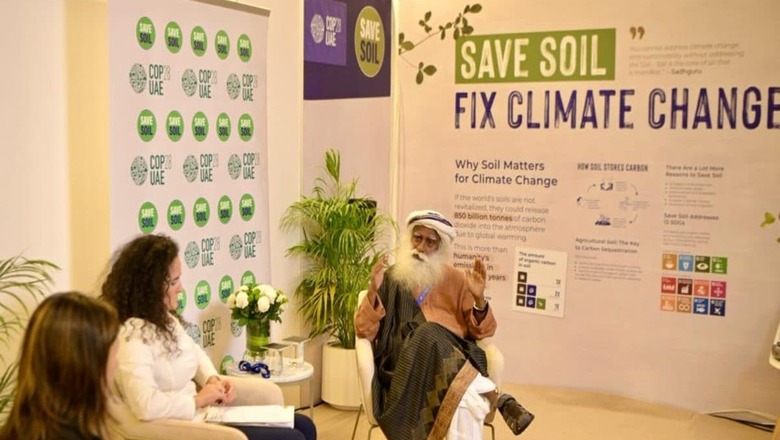
views
Just a few days ago, someone asked me at the COP28 in Dubai, “What should our global priorities be right now, in order to reverse climate change?” So far, when it comes to climate change, fossil fuels have been the biggest priority. Fossil fuels are important. I am not questioning that. But if you want to shift away from fossil fuels, you need technological innovations and breakthroughs. There has been reasonable progress, but when it comes to technological innovations, we do not know whether they will come in three months or three decades. That means we are investing in something which may or may not happen.
However, globally, over five billion hectares of land is under agriculture. Human hands are tending to this land on a daily basis. If we change the way this soil is managed and cared for, it could mitigate 37 per cent of the climate issues. If we ignore this opportunity and keep talking about capturing carbon dioxide in the air with some technology, that will not be a wise way of investing our money, resources and energies. Agricultural soil should be the first thing we change because it is the easiest step.
Above all, over 60 to 64 per cent of the world’s population is involved in agriculture. This is generally the poorest, most impoverished part of society. If climate action and climate action funding do not go in their direction, and instead go to a small stratum of technology-based people, it would be a very unfair distribution. Climate funding must go to people who are on the land because they are the ones who can make a difference. This funding should not be in the form of subsidies but as incentives to take the right action.
It is fortunate that at this COP28, for the first time, government and non-government parties have come up with agricultural declarations, making soil a significant part of the climate mitigation efforts. One of the fundamental aspects of this is to increase the green cover on the soil. Every extra green leaf that we put on the land is climate mitigation for the planet.
When it comes to increasing green cover, a lot of people talk about building back forests. But with the population pressures we have, particularly in tropical nations, building back forests is not going to become a reality. We will only talk about it. We can never actually do it. You cannot go to a village in India and tell them, “We are going to turn your village into a forest.” We certainly have to protect the existing forests, but if we want to increase the vegetation on the planet, we have to work on agricultural land, and the only way it can be done is by shifting farmers to tree-based agriculture.
To make this a reality, we need to make farmer-centric policies which are single-pointed, simple, implementable and incentive-based. For example, right now, we have worked with one of the state governments in India, and they are giving the farmers a growth-based incentive of Rs 125, for each tree, over a period of four years. The tree is being watched, and as it grows, farmers will get the money straight into their bank account. Without this kind of incentive-based agenda, simply doling out subsidies will just encourage people to sit back without any activity or productivity.
Another thing we must do is to shift the focus of investments in technology companies from simply thinking of alternative fuels — which also must happen, I am not against that — to evolving fertilisers, pesticides, and farm machinery that are more soil-friendly. We need robotics to create small machines to plant seeds, weed and perform other functions because all the machines that we have today for agriculture are brutal giants which just rip the soil apart. If small-scale, AI-based machines that apply fertiliser and pesticides in a doctored manner become available, we can also curtail the problem of mass application of chemicals.
Coming to generating finance for climate action, I know this may sound impractical right now, but we must move in the direction where we tax the arms and armaments that are produced a tiny little bit, maybe one per cent. For the amount of money that is being spent on arms, that one per cent would amount to a significant amount, and that could go into climate action. If you fire one bullet less, not only is one life saved, but it also prevents the damage that producing a bullet would have caused, which is quite a lot.
But will governments do this? An elected government usually has a term of four to five years and would not be willing to invest in climate action, which produces results in 15–20 years, unless citizens stand up and speak. If sixty per cent of an electorate demands, “What about our children? What are you doing for them? If you don’t do this, we will not elect you,” then it will become an electoral issue. Once it becomes an electoral issue, that is when action happens.
It is time we realise that the preservation and nurturing of this planet is not different from aspiring for a good life for ourselves. There is no good life without a good planet. This awareness and maturity needs to arise in the people, businesses, industry, and governments if we have to turn around climate change.
Ranked amongst the fifty most influential people in India, Sadhguru is a Yogi, mystic, visionary and a New York Times bestselling author. Sadhguru has been conferred the Padma Vibhushan by the Government of India in 2017, the highest annual civilian award, accorded for exceptional and distinguished service. He is also the founder of the world’s largest people’s movement, Conscious Planet – Save Soil, which has touched over 4 billion people. Views expressed in the above piece are personal and solely those of the author. They do not necessarily reflect News18’s views.


















Comments
0 comment